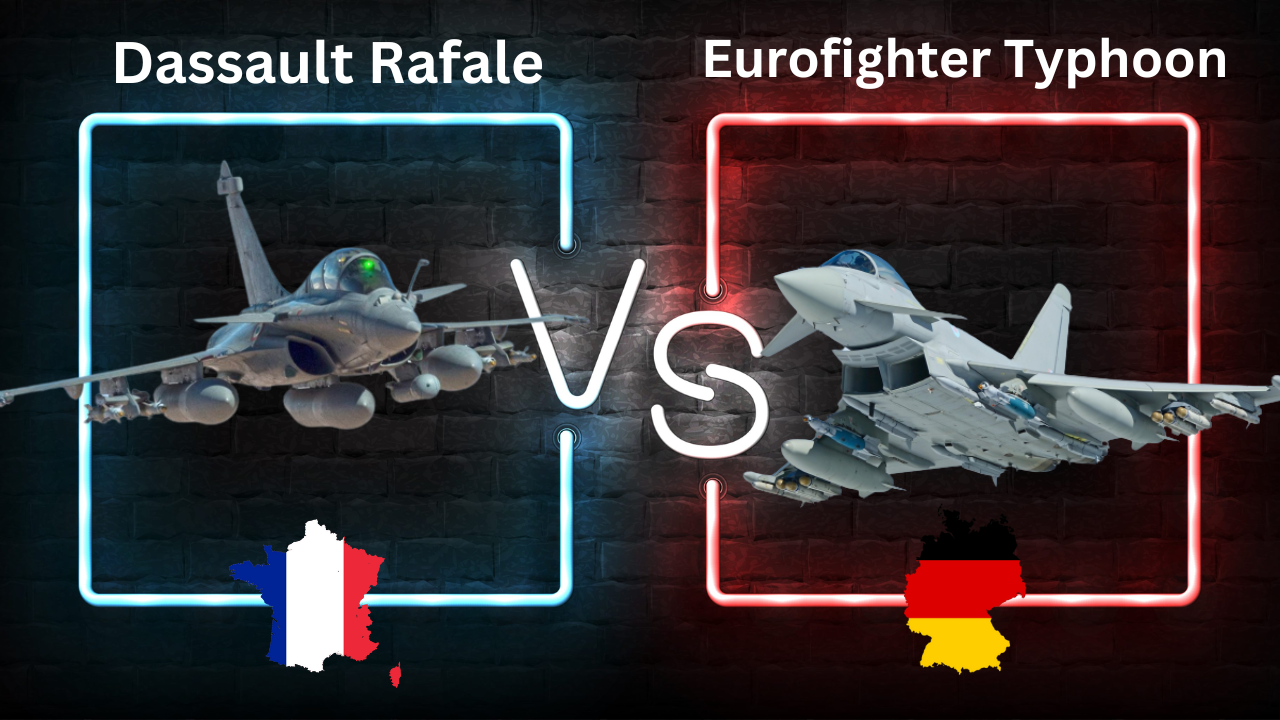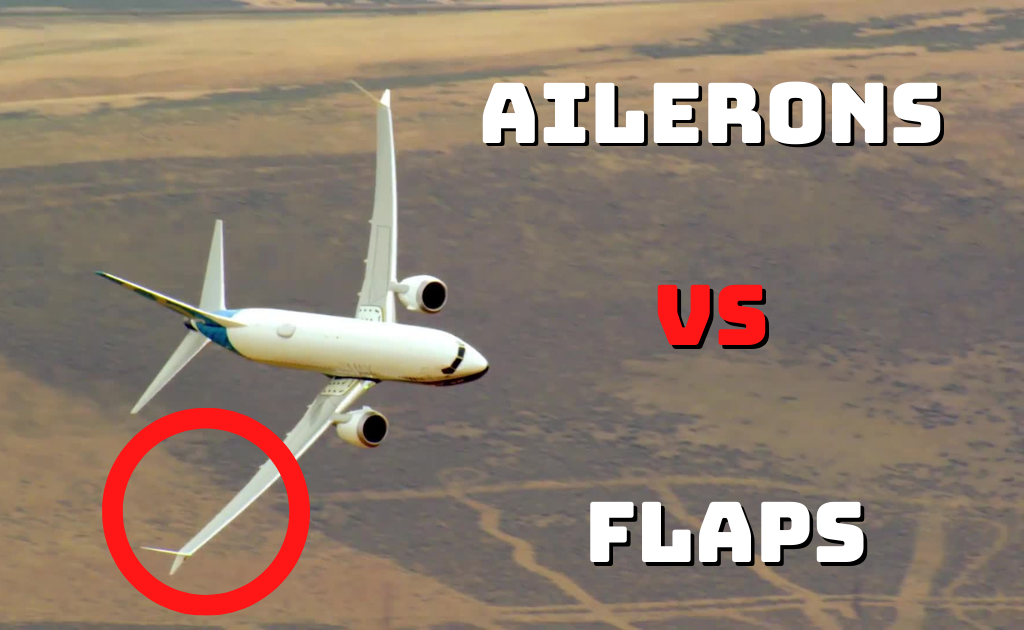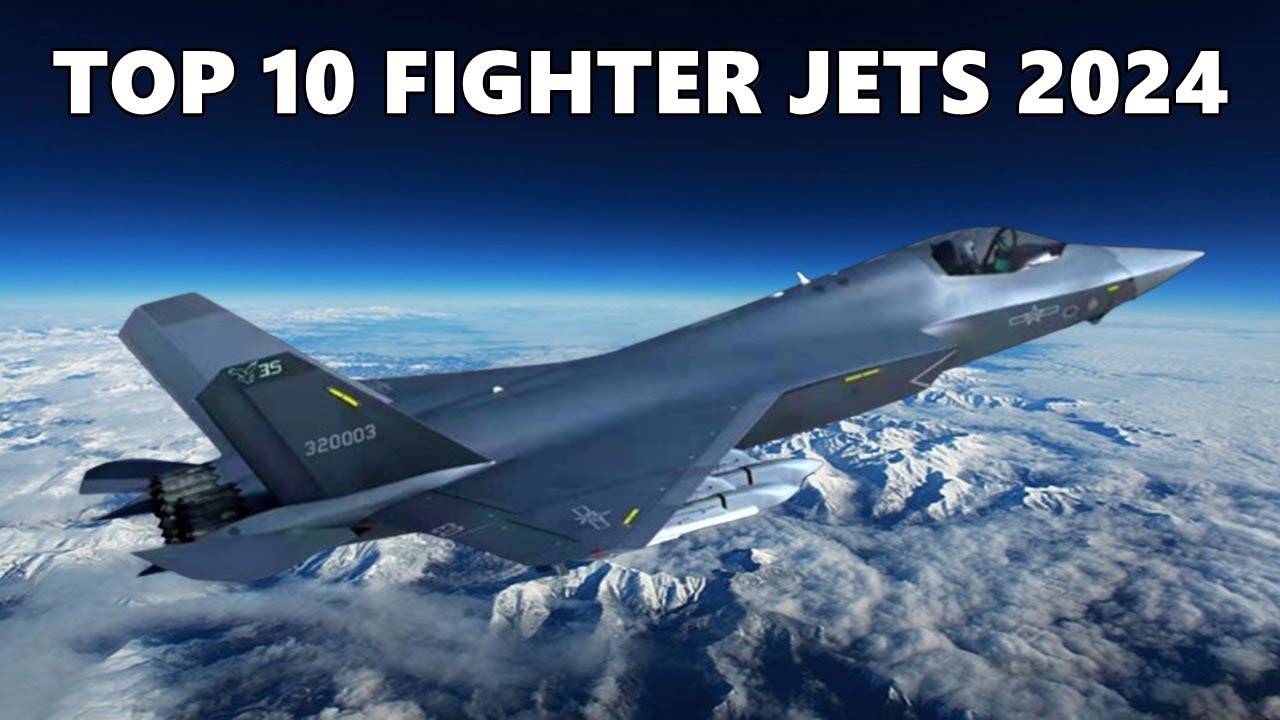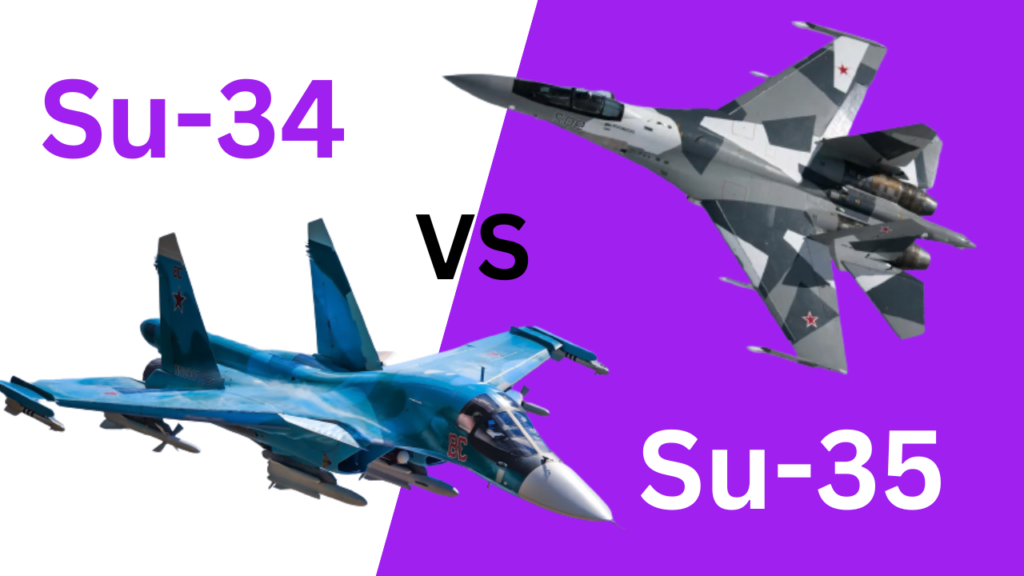
Let us dive into a sharp comparison between Su-34 and Su-35. But why compare them?
Reasons to compare
- Sukhoi Su-34 and Su-35 are 4+ gen and 4++ gen, respectively, and are very capable fighter jets in the Russian aviation sector.
- They belong to the same Flanker family, so a competitive comparison between them could tell us which jet is more powerful and advanced.
The Sukhoi Su-34
The Sukhoi Su-34, or Fullback as it is commonly known, is a dedicated Fourth Generation two-seat fighter-bomber/strike fighter platform developed from the very effective Su-27 “Flanker” series of air dominance fighters for the Russian Air Force.
The Su-33 (“Flanker-D”) navalized multi-role variant and the Su-35 long-range, air superiority/strike series are only two examples of the offspring of the Flanker family of aircraft, which originated in the 1970s at the Sukhoi Design Bureau and entered service in December 1984.
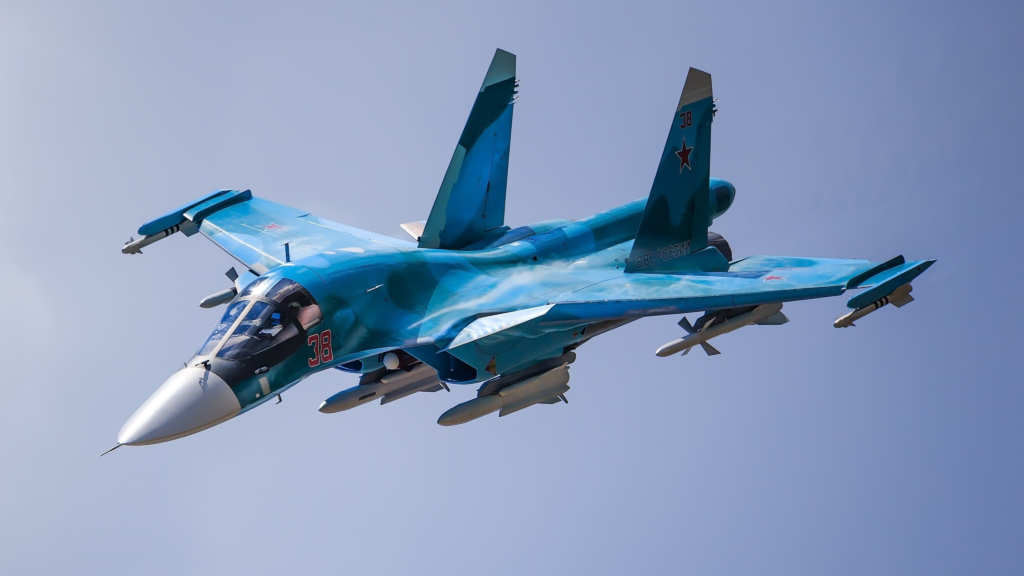
Although it shares many similarities with the Su-27 and is based on that aircraft’s design, the Su-34 is considered an entirely unique aircraft design due to its extensive modifications and primary strike duty rather than secondary air superiority.
Su-34 Design and Cockpit
The Su-34’s nose portion has been modified to make room for a cutting-edge, multi-mode, phased array radar that can either follow the ground or avoid it.
Its take-off weight has increased due to the addition of a second seat and larger fuel tanks compared to the original single-seat design. The center boom of the tail has been modified to accommodate a radar system that can scan the area behind the ship.
The cockpit is outfitted with a pair of K-36DM zero/zero ejection seats that sit side by side. Zvezda Research and Production Enterprise Joint Stock Company of Moscow is the supplier of the seats. Multi-information displays in the cockpit provide pilots with information on aircraft performance, unit condition, and tactical information.
Su-34 Systems
The Urals Optical and Mechanical Plant (YOM3) provided the Su-34 with its electro-optical firing control system, and the aircraft also features a Geofizika FLIR pod that can detect infrared from the front. The electronic countermeasures suite, TsNIRTI, and the passive phased array radar system are both supplied by Leninetz of St. Petersburg.
Weapons onboard the Su-34
180 rounds of ammo and a 0.03 m GSh-301 cannon are mounted on the Su-34. The gun can fire 1,500 rounds per minute at its maximum rate, and its muzzle velocity is 860m/s. The Instrument Design Bureau, Tula, provides it.
The aircraft has ten hardpoints for weapon payloads and can transport a variety of missiles, including guided and unguided bombs, rockets, air-to-air, air-to-surface, anti-ship, and anti-radiation missiles. The target designator on the aircraft is installed.
The Vympel State Engineering Design Bureau, Moscow, is the supplier of the short-range air-to-air missile R-73. The R-73 is an all-aspect missile that can engage targets either head-on or in tail-chase mode. The missiles infrared homing has cooled.
The RVV-AE long-range air-to-air missile is made by Vympel and goes by the names RR-77 and AA-12, according to NATO. With a maximum speed of 3,600 km/h, the missile can intercept targets at distances ranging from 0.02 km to 25 km. The greatest vertical separation between the host aircraft and the target is 10 km, while the minimum range in the aft hemisphere is 0.3 km.
The RR-77 has terminal active guidance and inertial guidance with mid-course radio updates. Vympel is testing a new R-77 with solid fuel ram-jet propulsion that has a longer range.
A variety of precision-guided and unguided bombs and rockets, notably the KAB-500 laser-guided bomb created by the Region State Research and Production Enterprise, Moscow, are also carried by the Su-34.
Roles of Su-34
- Air-to-Air Combat, Fighter
- Interception
- Ground Attack (Bombing, Strafing)
- Special Mission: Anti-Submarine Warfare (ASW)
- Special-Mission: Anti-Ship
- Intelligence-Surveillance-Reconnaissance (ISR), Scout
Variants of Su-34
Some of the variants of this fighter jet are –
- Su-34 (“Fullback”) – Base Series Designation.
- Su-34M – Modernized variant
- T-10V-1 – Initial Prototype Designation
- Su-27IB – Project Redesignation
- Su-32 – Export variant
- T-10V – Original Prototype Designation
The Sukhoi Su –35
The Sukhoi Su-35, or Flanker-E as it is more commonly known, is the newest member of the widely respected Su-27 “Flanker” series of air superiority planes. The original Su-27 originated as a Soviet Air Force project in the late 1970s, designed to compete with the American McDonnell Douglas F-15 Eagle.
The type’s tactical use in the ground assault role has grown substantially since then, and the line has even spawned the navy-focused, carrier-based Su-33. Marketed as a true 4th/4.5th Generation multi-role performance, the Su-35 is based on the successful and reliable Su-27 line and boasts the same air-to-air prowess while adding cutting-edge ground assault features.
The Su-35 was officially designated as such in 1993, albeit it had been in development since the 1980s as a modified Su-27M series.
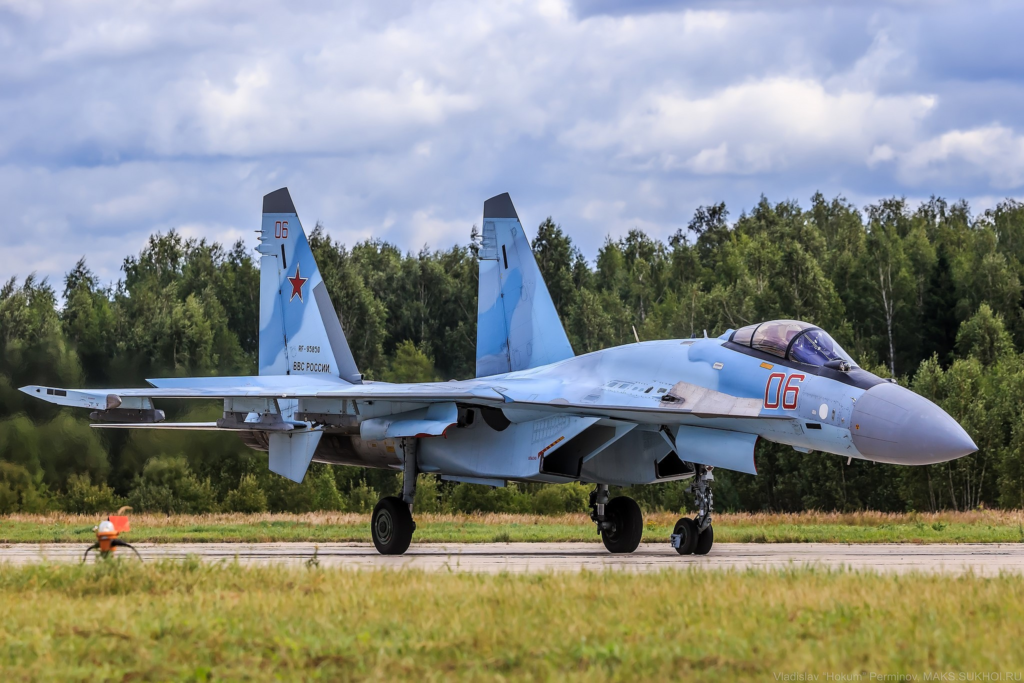
Russian officials began testing the first of ten prototype Su-35s in 1996, four of which were modified versions of existing Su-27s. When compared to the Su-27, the Su-35 stands out for its superior multirole capabilities, state-of-the-art avionics, extended range, fuel-efficient NPO Saturn 117S engines, and sleek, aerodynamic design. After extensive testing, the first flight was documented in June of 1998, and production was officially launched.
Su-35 Flanker-E design and cockpit
The Su-35 measures 21.9m (71.85 ft) in length, 15.3m (50.2 ft) across the wings, and 5.9m (19.3 ft) in height. Its maximum payload is 8,000 kg, and it only takes one person to fly the plane. The cockpit is outfitted with a central control column and a Zvezda K-36D-3.5E zero-zero ejection seat, allowing the pilot to eject with no loss of altitude or speed.
Avionika Moscow Research and Production Complex JSC designed and built the aircraft’s quadruplex digital fly-by-wire control system (MNPK Avionika). There are two high-resolution MFI-35 liquid crystal screens in the cockpit, each measuring 230mm by 305mm, and a 20° x 30° field-of-view IKSh-1M head-up display.
The pilot has access to two separate VHF/UHF encrypted radio communications systems, as well as a military data link system that is resistant to jamming both within the squadron and between the aircraft and ground control. Digital maps are used as the basis for the navigation system, which also makes use of GPS and a strap-down inertial navigation system.
Structure of Su-35
The Su-35’s front fuselage has a wider diameter compared to the Su-27, from which it was adapted in order to fit the Irbis-E radar’s larger 0.09 m antenna.
The radomes, nose wheel, door, and leading-edge flaps are non-structural components made of high-strength, lightweight composite materials. Some of the fuselage structures are made of an alloy of aluminum and lithium, and carbon fiber.
Weapons onboard the Su-35
The aircraft has 12 hardpoints for storing and transporting external weaponry. There are four hard points on each wing: one on the wingtip and three under the wing. There are two hardpoints under each engine and two along the centerline of the fuselage.
The Vympel R-27, the Vympel radar-guided medium-range R-77 (AA-12 Adder), and the Vympel short-range infrared-guided R-73E are all possible air-to-air missiles for the aircraft.
The Molniya Kh-29 (AS-14 Kedge) tactical missiles, the Kh-31P (AS-17 Krypton) anti-radiation missiles, and the long-range Kh-58UShE (AS-11 Kilter) anti-radiation missiles are among the air-to-surface weapons carried by aircraft.
The Kh-31A, the long-range Kh-59MK (AS-18 Kazoo), the long-range Kalibr, and the NPO Mashinostroenia heavy long-range Yakhont missile are among the Su-35 anti-ship missiles.
Roles of Su-35
- Air-to-Air Combat, Fighter
- Interception
- Ground Attack (Bombing, Strafing)
Variants of Su-35
Some of the variants of this fighter jet are –
- Su-35S (S = “Combatant”) – Primary operational model of the Russian Air Force based on the T-10BM prototype.
- Su-37 (Flanker-F) – Experimental Multi-Role Fighter; single seat; thrust vector control and many others like –
- Su-27 (Flanker), Su-27M (T-10S-70) – Prototype Su-35 billed as “improved” Su-27 design, Su-35 (Flanker-E), Su-35UB, and Su-35BM.
Su-34 vs Su-35
Basics
| Fighter Jet: | Su-34 | Su-35 |
| Origin: | Russia | Russia |
| Year: | 2014 | 2014 |
| Crew: | 2 | 1 |
| In Service Fighters: | 140 | 106 |
Dimensions
| Fighter Jet: | Su-34 | Su-35 |
| Length: | 23.3m (76.6 ft) | 21.9 m (71.9 ft) |
| Width/Span: | 14.7 m (48.2 ft) | 15.3 m (50.2 ft) |
| Height: | 6.1 m (20.0 ft) | 5.9 m (19.4 ft) |
Performance
| Fighter Jet: | Su-34 | Su-35 |
| Maximum speed: | 1900 km/h (1180 mph) | 2,400 km/h (1,500 mph) |
| Cruise speed: | 1,300 km/h (810 mph) | 1,170 km/h (730 mph) |
| Combat range: | 1,100 km (680 mi) | 1,600 km (990 mi) |
| Ferry range: | 4,500 km (2,800 mi) | 4,500 km (2,800 mi) |
| Service ceiling: | 17,000 m (56,000 ft) | 18,000 m (59,000 ft) |
| g limits: | +9 | +9 |
| Thrust/weight: | 0.68 | 1.13 with 50% fuel 0.92 with full internal fuel |
Speed and Range
In terms of speed, Su-35 defeats Su-34 by a thin margin. Su-34 can achieve a speed of 1,900km/h at altitude and 1,300km/h at sea level and has a flight range of 4,000km.

On the other side, the Su-35 has a top speed of 2,400 km/h. The aircraft’s normal and ferry ranges are 3,600 km and 4,200 km, respectively. The highest point is 18,000 m.

Engine and System
Su-34
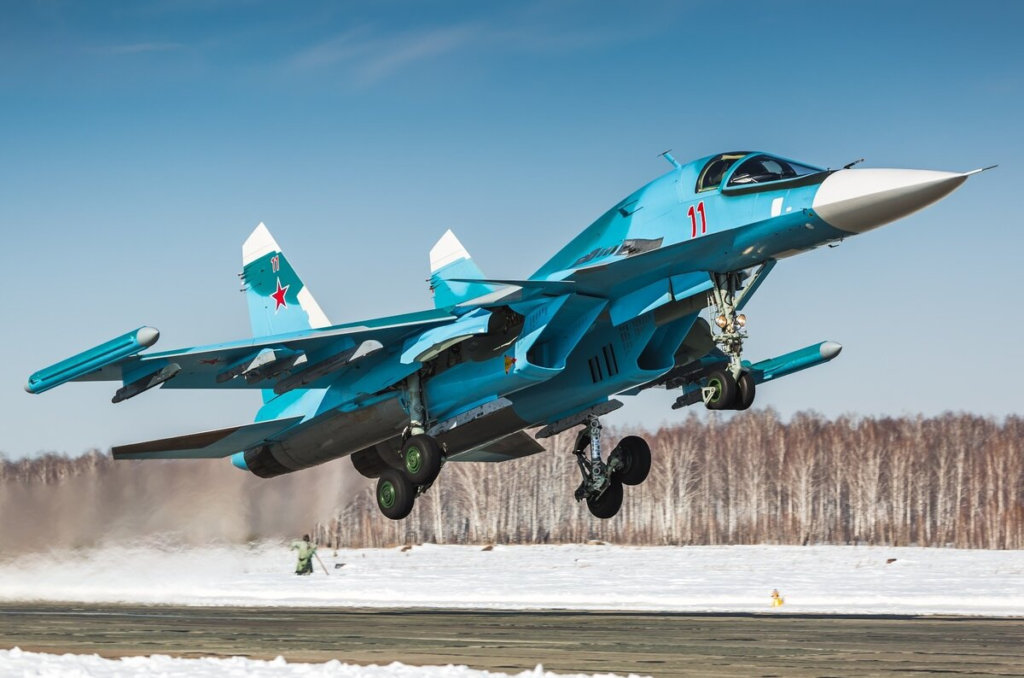
Two NPO Saturn AL-31F turbofan engines that burn after combustion power the first batch of manufacturing aircraft. Later models of aircraft might be powered by NPO Saturn 117 or MMPP Salyut AL-31F-M2/3 engines. They have all-duty fixed geometry air intakes and are positioned beneath the wing. The air intakes have rotor protection added to guard against foreign objects being ingested.
The aircraft’s internal fuel capacity is 12,100kg, which may be stored in two fuel tanks in the wings and four in the fuselage. Additionally, three extra 3,000-liter fuel tanks can be installed.
Su-35

Two Sturn/UFA AL-31F 117S turbofan engines with thrust-vectoring nozzle control, each producing 86.3kN of thrust or 142.2kN with afterburn, power the aircraft. The engines were created in collaboration with UMPO, Saturn, and Sukhoi.
There are 14,350 liters of gasoline capacity in total. The Su-35 has more tailfin and fin-root tanks than earlier variants, which increases its range and endurance without refueling. The square-tip twin tailfins, fuselage, and wings all house the fuel tanks, which are made of aluminum lithium. With internal fuel, the range is 1,580 km.
The aircraft has a refueling probe on the port side of the nose for in-flight refueling. An additional 4,000 liters of fuel are provided by two external fuel tanks of type PTB-2000.
FAQ
- Is the Su-34 any good?
- The Su-34 has a striking appearance. The design uses the Su-27’s airframe but adds a cockpit with side-by-side seating for two people. The Su-34 can carry 12 tons of bombs and missiles, including air-to-air missiles, and can launch attacks on targets up to 600 miles distant.
- How many Su- 34 does Russia have?
- 7 prototypes and 140 operational aircraft as of June 2022
- Is the Su-35 overrated?
- However, the Su-35 wins the prize for being the most overhyped fighter in the 4++ generation. It is advertised as “world-beating,” which it is not even close to being.
- Is Su-35 any good?
- The Su-35 is unquestionably the most competent fighter in the Russian Air Force, and it poses a real danger to any fourth-generation aircraft currently in operation. But to claim that it is comparable to modern F-15E, F/A-18E/F, Typhoon, or Rafale aircraft, much less “better,” is absurd.
- Is Su-35 better than Rafale?
- In reaction to the US-made F-15, the Flanker was created during the Cold War. The Russian aircraft can fly at 2.25 Mach and at a higher altitude, whilst the French masterpiece can only reach a top speed of 1.8 Mach. So the Su-35S is unquestionably the winner in this regard.
- Can a stinger take down a Su-35?
- According to military specialists, the Su-35S of the Russian Air Force shares the same sort of tail fuselage. Ukrainian reports claim that a Ukrainian Stinger missile brought down the Su-35S.

